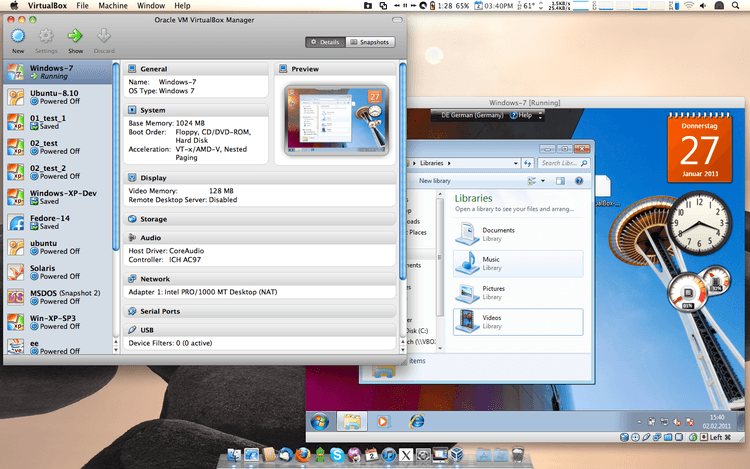
- #HYPER V VS VIRTUALBOX FOR LINUX INSTALL#
- #HYPER V VS VIRTUALBOX FOR LINUX FULL#
- #HYPER V VS VIRTUALBOX FOR LINUX WINDOWS 10#
- #HYPER V VS VIRTUALBOX FOR LINUX PRO#
- #HYPER V VS VIRTUALBOX FOR LINUX CODE#
I had hoped I could just use Hyper-V or WSL2 and get by instead of silly annual upgrades. I used to boot windows and just go into my VMWare Ubuntu Desktop for work. I have never really liked it too much because, but its free and works better than Hyper-V so. Still pretty usable if you need something free. Don't run anything like production on it. Vbox backed, was typical installation on Windows and is still an option. It's not too bad but I have had file corruption which never happened on Docker with vbox. It is slow and Docker will warn you about shared drives. Ubuntu 2020 works fine and performance is decent.


#HYPER V VS VIRTUALBOX FOR LINUX CODE#
VS Code seems to be able to launch this shell. So it's pretty much like using Linux shell on windows which has a lot of advantages when doing development. Its fast, has automatic mount for my drives. Good enough for development work and running bash/zsh so I don't have to remember the difference between ls and dir I can still just launch it from start bar.

Have not tried it but at least you have an option now as opposed to Windows Evaluation copy. Sure you could go read a 100-internet-page on performance, but why. I have used Ubuntu since 2005 and have no issues with it but it just isnt doing well on AMD Threadripper, quite possible its the kernel level issues. It is not stellar but definitely better than Ubuntu. I am really glad to see WSL2 do so much better so now I can actually stop using MacOS or Ubuntu for most of my work and stick to Win10 which has better support for my CPU/Motherboard. Docker (not really VM but I am using Docker WSL2 as opposed to Virtualbox).We have few options when it comes to doing Development or Testing work. I spent a great deal of time and money on various VM platforms so hopefully i can save you the same time/money.
#HYPER V VS VIRTUALBOX FOR LINUX PRO#
You only need Pro if you want to get Hyper-V and WSL2 support without hacking around with Windows preview builds.
#HYPER V VS VIRTUALBOX FOR LINUX WINDOWS 10#
I recently upgraded my Workstation to a Windows 10 Pro workstation edition. We could recommend VMware in the case of installing and using Windows and macOS in virtual machines, and VirtualBox if we plan to test Linux distros or very old operating systems.This is from my perspective of using Linux based distros as the main driver. If we are home users, and we are not going to make a very advanced use, either of the two programs can be perfectly useful.
#HYPER V VS VIRTUALBOX FOR LINUX FULL#
If we are a company and we want to take full advantage of virtualized operating systems, then we must choose VMware, specifically the “Workstation Pro” version, since it is the most advanced and complete. Therefore, the thing is between VirtualBox and VMware. Otherwise, although it is specialized in Windows, and it is where Microsoft’s operating system will work best for us, its complexity and limited options make it really not worth it. If we are going to use the Windows Subsystem for Linux, Sandbox mode, or very specific virtualization platforms, such as Docker, then we will have to enable the Windows hypervisor. The truth is that the use of Hyper-V is very clear. VMware, VirtualBox, Hyper-V… Which one should I choose? But if we have the Home edition we will not be able to use this program. Hyper-V does not have to be downloaded from anywhere, since it is a feature of Windows 10 Pro (although we will have to activate it manually).
#HYPER V VS VIRTUALBOX FOR LINUX INSTALL#
It offers very advanced features and even allows you to install virtual machines on real disks, disks that can then be used to boot any PC. Hyper-V, as a program for virtual machines, is a much more focused feature, especially for users who work in professional environments. When we have the virtual machine created, we can create a snapshot that allows us to return the virtual machine to its previous state at any time, we can clone it to use two equal machines at the same time, and even use ” Linked Clones “, a function that allows us creating copies of a VM without completely copying it and saving considerable space. It is compatible with smart cards, supports USB 3.0, integrates with vSphere / ESXi and vCloud Air, and has 3D graphics compatible with DirectX and OpenGL. Thanks to this program we will be able to easily share all kinds of files between our main PC and the virtualized one.

In addition to being able to configure the hardware that we want to dedicate to virtualization (for example, RAM, CPU, disk, etc.), we will also find a series of functions, options and advanced tools that will allow us, for example, to apply additional measures security and isolation of the VM, useful for companies. Among its main features we can highlight a large number of customization and configuration options for the machine that will allow us to have absolute control over the virtual machine.


 0 kommentar(er)
0 kommentar(er)
